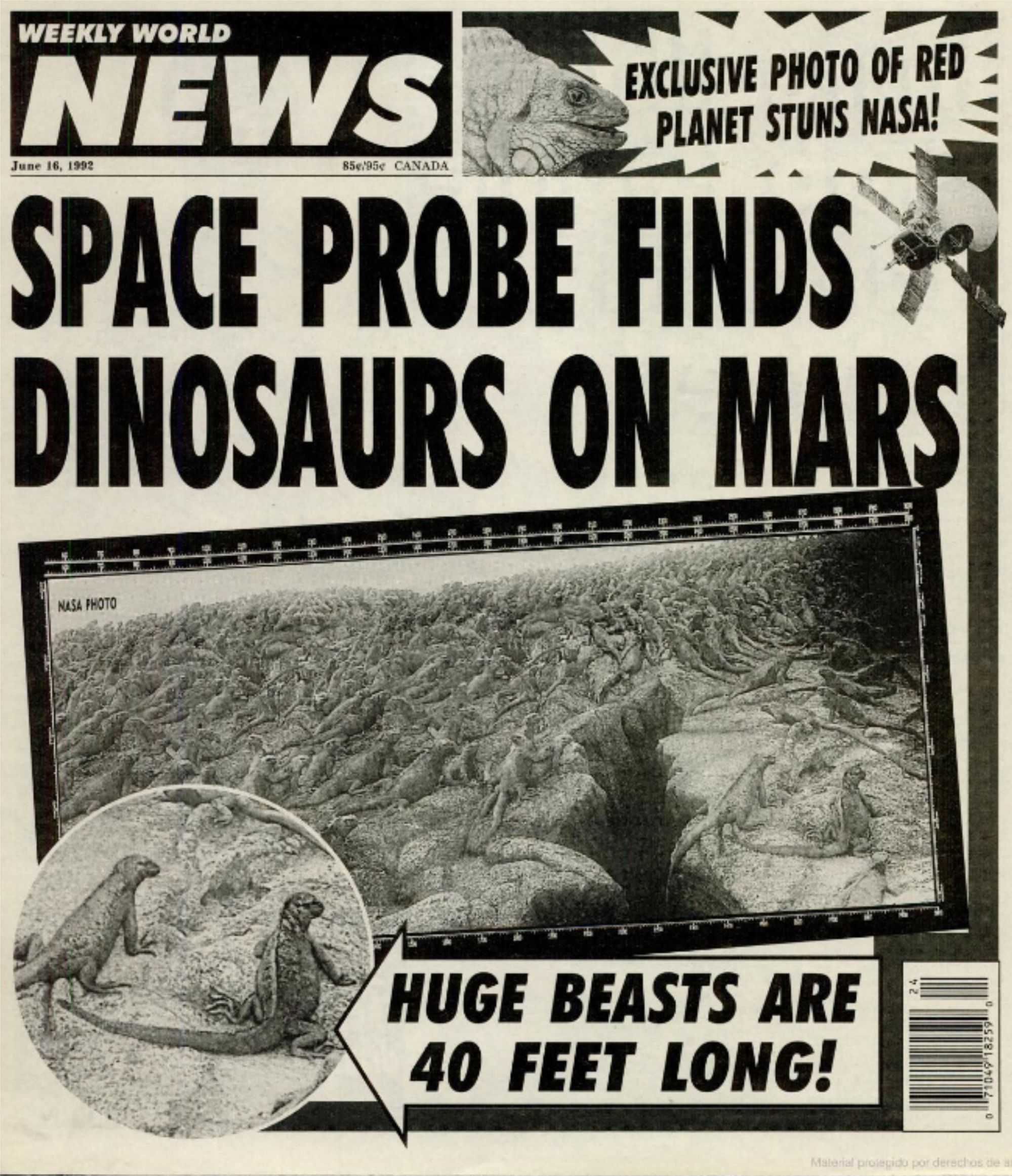Letters from the library
#21. Dinosaurs in Mars
Disinformation and fake news are not new things, born in the heat of the Internet and the ubiquitous social networks. They have existed since human beings are human beings, and since our species had the capacity to fantasize. For we all like a good story. To listen to it and to tell it. The more elaborate, the better.
Although, of course, when it comes to narrating there are some limits that should not be crossed. Like those imposed by credibility, for example.
Be that as it may, fake news has always been present in our societies, ancient and modern, rural and urban. We librarians are well aware of this phenomenon, and we have focused on combating it.
[Or not. There is room for everyone in the vineyard of the Lord].
Those of us born before the turn of the millennium ―and the explosion of ICTs, Information and Communication Technologies, and all the lack of control that followed― remember with a certain affection (and even with a certain tenderness, let's say it) certain publications dedicated to spread "extravagant" news. I call them that, making an impressive display of kindness, because at the time they received other sort of qualifiers. "Yellow media" and "tabloids" were the softest, and "crap that doesn't deserve to be printed on paper" one of the most common.
[Yes, they were printed on paper. Remember that I'm talking about the pre-Internet era. That paper was later used to wrap vegetables in the market, or eggs in the store, or Christmas decorations, or glasses, or plates... Or to clean glass...].
But I'm beating around the bush. I was talking about those media that propagated funny, fanciful, hilarious "extravagances"... There were many titles: actually, each country had its own selection. But the fame of some of these publications transcended borders, and their farces, fallacies, lies and hoaxes resonated internationally.
Weekly World News was one of them. Actually, it still is: a quick check shows me that they have a website where they continue their activities. It was famous in the United States between 1979 and 2007, and its covers were celebrated for showing mind-bending combinations of science fiction and parapsychology.
[It is necessary to clarify that many of these media, including WWN, offered content that was never presented as true, but as satire and a work of fiction and entertainment.
And it is also necessary to clarify that there were some readers who took these facts as realities. "Conspiranoids" are not a recent invention, either].
Among WWN's most fanciful covers is the one that hyped up the discovery of a galaxy in the shape of a human fetus. A note that was illustrated with a pregnancy ultrasound.
On June 16, 1992, Weekly World News published the cover I share. "Space probe finds dinosaurs on Mars. Exclusive photo of the red planet stuns NASA," it announced. And then it added: "The huge beasts are 40 feet long!"
The photo shows an agglomeration of Galapagos marine iguanas.
[They didn't even have to retouch a photo, or create plastic monsters…].
What for us, today, is something funny, could not have been so 30 or 40 years ago. Remember (again) that in the 90s there was no Internet, much less cell phones. And many people did not know what the Galapagos were, or where they were, or what fauna the islands had. A marine iguana could very well be a Jurassic monster to them. In fact, it was...
And now the backstage. How did I learn about this anecdote?
Within the process of recovery of history and memory that we are carrying out at the Library, Archive & Museum area of the CDF, we are requesting and receiving, as donations, the personal files of scientists who worked in the past at the Charles Darwin Research Station.
Those files include everything from manuscripts, reports, draft articles, and raw data to photos, slides, maps, plans, videos, cassettes, and drawings. And many personal emails and letters.
The surprises that one finds when organizing and curating those documents are endless. Trust me.
Going through the collection of Tom Simkin, a CDF geologist several decades ago, I found a photocopy of the WWN cover, with a smiling note addressed to some old CDRS comrades. And here it is necessary to understand, for the umpteenth time, that we are talking about the pre-Internet era. If today I find this image in a newspaper, I take a picture of it with my cell phone and upload it to a WhatsApp group, where several people (even dozens) can automatically see it at the same time. The process takes a few seconds, or at most a couple of minutes. But in the 1990s, Simkin (who was working at the Smithsonian Institution at the time) found the cover, took it to a photocopier, took a copy, added a note, put it in an envelope, and mailed it to the Galapagos for that his ex-colleagues could see it.
[He could have faxed it too, but the low quality of the original image would have faded further, to an unintelligible outline].
This is how I learned about the Galapagoan iguanas that were once Martian dinosaurs in an American tabloid.
What until now I do not stop wondering is: how many people did believe the story?
Keywords: History of Galapagos
Subject categories: Articles | Newspapers
Time framework: 1992
Text & picture: Edgardo Civallero (edgardo.civallero@fcdarwin.org.ec)
Publication date: 1 December 2022
Last update: 1 December 2022
